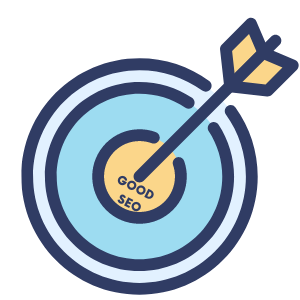Table of contents
Czytasz teraz:
Good SEO – What Does It Mean?
Close
Google and other search engines after entering certain keywords in a fraction of a second can show even 100 million results. It’s both a blessing and a curse. What does it mean? In short: to improve your site rank and get to TOP10 with such competition, you must put a lot of emphasis on SEO (Search Engine Optimization) activities and link building – in a nutshell, to compete in such a saturated market, you should have really good SEO. But what exactly is “good SEO”?
Google’s “pole position” is taken by the ones who mastered the most important ranking factors in their SEO strategy. These factors play a key role as they have a direct impact on the positions in the search engine results page. In this article, we will look at the some seo best practices and activities that Google values the most. What to do?
- A good SEO strategy should take into account the most important Google ranking factors – including keyword selection and technical aspects, such as Core Web Vitals.
- It’s good to know how search engines work. This process is divided into three stages: search, index, and ranking.
- Good SEO mostly consists of selected keywords, quality content, a properly optimized website and proper link building.
How do search engines work?
If you want your content to appear in search results, it must first be made visible to search engines. Therefore, to achieve good SEO, it’s important to understand how search engines work and what they take into account.
Crawling
At this stage, Google bots search for content by visiting websites and analyzing the entire content of the page. They take into account, among others, its layout and user-friendliness, ads, texts, images, keywords and links. It is an ongoing process – bots (sometimes called web crawlers) work all the time to keep the database up-to-date.
(You will find the rest of the article below the form)
Contact us and get a free quote
We will analyze your business and prepare an individual price offer for the optimal marketing mix for you. Completely free.
Verseo spółka z ograniczoną odpowiedzialnością with its registered office in Poznań, at the following address ul. Węglowa 1/3, 62-122 Poznań is an administrator of your personal data.
About Verseo
Company’s office is located in Poznań. Company is entered into the register of entrepreneurs, kept by the District Court of Poznań – Nowe Miasto i Wilda in Poznań, 8th Commercial Division of the National Court Division under number 0000596164, NIP (Tax Identification Number): 7773257986. You can contact us by writing a letter on the address indicated above or e-mail:[email protected]
You have right to:
- access to your personal data,
- correct your personal data,
- demand to remove your personal data,
- restrain to process your personal data,
- object of process your personal data,
- transfer your personal data,
- withdraw consent.
If you think we process your personal data not in accordance with the law, you have right to object to supervisory authority – President of Personal Data Protection Office.
We process your personal data to:
- handle your question, based on art. 6 ust. 1 lit. 6 of General Data Protection Regulation
- promote our goods and services including ourselves in connection with your consent, based on art. 6 ust. 1 lit. a of General Data Protection Regulation
- protect or claim in connection with our reasonable interest, based on art. 6 ust. 1 lit. f General Data Protection Regulation
You share your personal data freely. Please remember that without sharing your personal data you will not be able to send us a message, and we will not be able to answer you.
We can share your personal data with trusted recipient:
- providers of tools made for: website analytics, marketing automation,
- hosting operators.
We will process your personal data by the time:
- which is necessary to achieve a specific purpose for which they were collected and after this term by the time which is necessary to protect or possible claim,
- of withdraw your permission .
We don’t process personal data in a way, which would involve making only automated decisions about you. More information about processing of personal data you can find in our privacy policy.
Indexing
Indexing can be described as an actual analysis of the content. All the data collected by the bots is sorted and placed in huge databases that are constantly updated by re-indexing the websites.
Ranking
The stage at which the content is chosen to be shown in response to a specific keyword that was typed into the search engine. Each time a keyphrase is entered, the search engine displays the results that are, or at least should be, most relevant. Responsible for these mechanics are advanced algorithms that together are called an all-mighty Google algorithm – one to rule them all. Google algorithm takes into account over 200 factors while setting the ranking.
At this point, it should be added that users’ choices matter. The user selects an item from the list of search results, and this action, together with subsequent activity, affects the algorithms.
How to get to the top in search engine rankings?
What actions can you take to get your website well-rated by robots and appear high in search results? What to do to have “good SEO”? Here are some tips:
Keyword research and creating a list of keywords
It is worth taking the time to analyze how your potential customers search the Internet for products or services similar to those offered by you. To attract traffic from search engines, you need to include in your content and link the keywords people are looking for. Keywords and SEO are closely related, so make a list of keywords that match what you are searching for on the web. Proper keyword selection can make search traffic evolve into sales. How to do keyword research? Here are some things to start with:
Identify the problems and the needs of your audience – the goal of SEO is to attract organic traffic to your website by showing users that you have the solution they are looking for. However, to do this, obviously, you first need to know what exactly they need. Find out what your audience’s problems are, and then use keywords related to the topics in your texts.
Be an industry expert – and prove it with your content. If you’re selling a product or service, you need to know what you’re offering. Read the specifications of your products in detail, and use professional, specialized vocabulary. Good knowledge of the topic not only helps with SEO but also makes you an authority – in other words, a better source of information for consumers who come to you for help and information.
Check your business rivals – your competitors can prove to be a valuable source of information when it comes to keywords that are relevant to your industry. Audit their websites and find some keywords.
Use low competitive phrases – popular keywords used by everyone will most likely not help you. Focus on keywords that are less competitive and you will increase the chance of getting a higher ranking. You can find more about such keywords in another article on Verseo Blog: Long Tail Keywords – That Are They?
Track trends – seasonal trends can make a big difference to your keyword selection strategies. If you have a product or service that is seasonal (or you can sell it as seasonal) use keywords like “Christmas sweater”, “winter ski jacket”, “spring 2022 fashionable coats” etc.
Don’t be afraid of SEO tools – There are tons of tools specifically designed to analyze SEO activities that will help you do your keyword research. Thanks to them you will find out what works and what does not. Check the list of free tools here and choose your favourite keyword research tool.

Use your keywords!
Once you have done your research and have prepared a list of keywords, the next step is to publish them on the website to improve their visibility in the search engine – to make the most of their potential. What do we advise?
Give every subpage a unique title – each URL shoutheirld have its unique title, which responds to users’ inquiries in the most natural way. Therefore, keywords should appear in the title.
Create a page description (meta descriptions) – add keywords to the descriptions and the search engine will automatically bold them in SERPs (Search Engine Results Pages) so that users can easily find what interests them by scanning the text. Note: meta description does not influence SEO itself, but acquires search traffic via purely human curiosity.
Set friendly URL addresses – each subpage has its URL. It is a good idea to include keywords in the addresses, as the automatically generated URL in many CMS systems will not be readable by users, nor will it be appreciated by Google crawlers.
Use headers (H1- H6) – with headers the information provided in the website content will be easier to comprehend both for users and search engines. There are 6 levels of headings, the most important title tag is H1.
Set alt description in image attributes – keywords in files data, consistent with what they present, will make your website better positioned in Google images section. Alt attribute is also very useful for visually impaired people – the user can hear the description using the voice generator.
Use internal linking – thanks to internal linking, Google crawlers move between subpages, and the greater the number of internal links to a given subpage, the stronger the signal for the crawlers.
Fill the content on the page with keywords. But be careful – this process should be done skillfully. Overfilling the content sometimes makes it very hard to read, and users will simply enter and within a second leave your website. You want to attract and maintain attention, therefore you have to respect your users – give them the content they deserve and don’t take shortcuts. Therefore, it is worth reaching for synonyms and other variations of a given phrase.
Search engine optimization of the website
A keyword analysis is one of the foundations of SEO, but Google’s algorithm analyses much more than just keywords. Many of the 200 ranking factors focus on the technical aspects of websites. What should you take care of? Here are some suggestions:
Improve website navigation – navigation should be as intuitive and easy as possible. Good navigation will not only satisfy users but can also help crawlers in finding and indexing subpages.
Beware of error 404 – all the effort and hard work to attract organic traffic to your website can be wasted if users receive a 404 error after clicking on the link. Creating redirects for 404 links is a must, because not only can you lose a potential customer, but also make it difficult for crawlers to index your page.
Don’t underestimate mobile traffic – your website has to be displayed correctly on mobile devices. After the introduction of Google mobile indexing a few years ago, the lack of responsiveness will negatively affect the position of your website in the search results.
Reduce the loading time – more than half of users leave a website that takes more than 3 seconds to load (and this “waiting period” is getting shorter and shorter every month). Thus, page loading time affects conversion. You can improve the page speed by:
- compression of photos and other images,
- reducing the size of files with the website code,
- uninstalling unnecessary plugins,
- checking the hosting performance,
- minimizing the number of redirects,
- implementing the Gzip compression on the website,
Write relevant content – your articles, product descriptions and other pieces of content, even every single blog post have to be valuable. Quality content extends the time spent on the website, lowers the bounce rate and provides useful information for users. Remember – only unique texts, no duplicate content. All this is appreciated by Google crawlers and of course the search engine algorithms.

Good SEO – summary
What influences good SEO? As we can see above – many factors, but good SEO is primarily based on properly selected and used keywords, creating quality content and a properly optimized website. However, the details are changing almost daily. We recommend watching the updates to the guidelines from Google to stay up to date with what the search engine algorithms appreciate the most.












